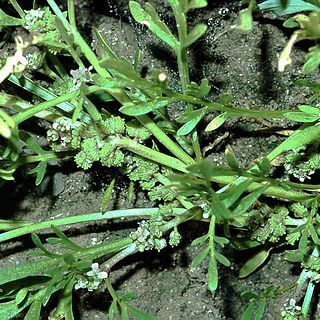Annual or biennial herb; stems 5–30 cm long, prostrate, glabrous. Basal leaves petiolate, to 10 cm long, deeply pinnatisect; lower lobes pinnatifid, grading to entire above; stem leaves becoming less divided. Inflorescence a raceme, shorter than leaves at maturity. Sepals c. 1 mm long, persistent. Petals 1–1.5 mm long, white. Stamens usually 6. Style c. 0.5 mm long. Silicula ± reniform, 2–3 mm long, 3.5–4 mm wide, base emarginate (notched), apex acute, narrowed to style above; valves rounded, somewhat constricted at septum, reticulate-pitted and/or irregularly ridged (with prominent ridges and peaks), indehiscent, not separating into 1-seeded units; pedicels 1.5–2 mm long, thick. Seeds 2–2.5 mm long.
A procumbent glabrous herb. Leaves pinnatipartite with obovate segments; segments of lower leaves pinnatifid or lobed, segments of upper leaves narrower, entire. Racemes much contracted, almost capitate in flower; in fruit up to 4 cm long, dense. Sepals about 1 mm long, greenish-white, persisting round the fruit. Petals about 1.5 mm long, white. Stamens 6; filaments subulate-filiform. Siliculae on stout, spreading-erect, 1-2 mm long pedicels, 2.5-3 mm long, 4 mm broad, reniform to reniform-obcordate, without an apical sinus between the 2 halves, indehiscent; valves strongly tuberculate and ridged; style short, stout, pointed.
A cabbage family herb. It grows from seed each year or can take 2 years to complete its life-cycle. The leaves at the base are in a ring. The leaves are divided one or two times. The flowers are small and white. They are in crowded clusters spaced along the stem.

